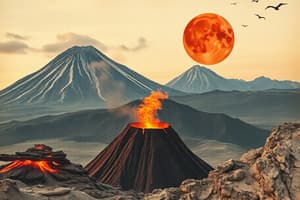Podcast
Questions and Answers
What characterizes an active volcano?
What characterizes an active volcano?
- No history of eruptions
- Presence of hot water springs and seismic activity (correct)
- Has not erupted for a long period
- Only erupts under specific conditions
How does an extinct volcano differ from a dormant volcano?
How does an extinct volcano differ from a dormant volcano?
- A dormant volcano has no known history of eruption.
- An extinct volcano has erupted more recently than a dormant volcano.
- An extinct volcano may erupt based on seismic activity.
- An extinct volcano is considered permanently inactive. (correct)
What geologic feature is primarily responsible for the Philippines having many active volcanoes?
What geologic feature is primarily responsible for the Philippines having many active volcanoes?
- Mountain ranges
- Tectonic plates and subduction zones (correct)
- Ocean currents
- Inland lakes
Which of the following volcanoes in the Philippines last erupted in 2011?
Which of the following volcanoes in the Philippines last erupted in 2011?
Which island group in the Philippines has the greatest number of active volcanoes?
Which island group in the Philippines has the greatest number of active volcanoes?
What is the main reason why the Philippines experiences some of the deadliest eruptions?
What is the main reason why the Philippines experiences some of the deadliest eruptions?
Which volcanic feature signifies a volcano that can erupt but currently has no recorded eruptions?
Which volcanic feature signifies a volcano that can erupt but currently has no recorded eruptions?
Which of the following statements about the Pacific Ring of Fire is accurate?
Which of the following statements about the Pacific Ring of Fire is accurate?
Flashcards are hidden until you start studying
Study Notes
Volcano Activity Types
- Active volcanoes are marked by seismic activity, hot springs, and changing crater elevations.
- Active volcanoes can erupt at any time.
- Dormant volcanoes have no recorded eruptions but may become active due to seismic changes.
- Extinct volcanoes have not erupted for an extended period and show no signs of activity.
Volcanoes in the Philippines
- The Philippines lies along the Pacific Ring of Fire, which contributes to the presence of active volcanoes.
- A total of 23 active volcanoes are located in the Philippines, primarily along convergent plate boundaries.
- Major active volcanoes include:
- Bulusan (Sorsogon) - Last erupted on May 13, 2011
- Kanlaon (Negros Oriental) - Last erupted on July 25, 2006
- Mayon (Bicol) - Last erupted on December 20, 2009
- Pinatubo (Southern Luzon) - Last erupted on August 16, 1992
- Taal (Batangas) - Last erupted on October 3, 1977
Volcano Distribution and Tectonics
- Luzon has the highest number of active volcanoes in the Philippines.
- The formation of volcanoes correlates with tectonic plate boundaries and movements.
- Small tectonic plates are present between larger plates in the Philippines, influencing volcanic activity.
- The relationship between tectonic plates and volcanoes is characterized by subduction zones, particularly involving the Philippine Plate and Eurasian Plate.
Eruption Characteristics
- Volcanoes in the Philippines are prone to some of the most dangerous eruptions due to their tectonic settings.
- The region's seismic activity and geological features contribute to the variability in volcanic behavior.
Studying That Suits You
Use AI to generate personalized quizzes and flashcards to suit your learning preferences.




